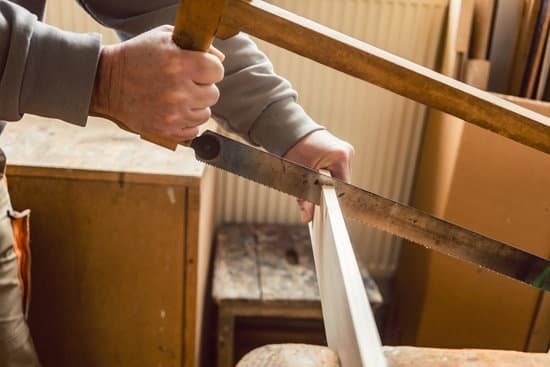Are you wondering why use butterfly ties in woodworking? Butterfly ties, also known as dovetail keys or Dutchman’s keys, are small, butterfly-shaped pieces of wood that are used to strengthen and stabilize wood joints. In this article, we will delve into the concept of butterfly ties in woodworking and explore their significance in enhancing the structural integrity of wooden furniture and other woodworking projects.
The history of butterfly ties dates back to traditional woodworking practices, where they were used to repair cracks and splits in wooden surfaces. Over time, their role has evolved to not only serve as a method of reinforcement but also as a decorative element in woodworking. Understanding the benefits of incorporating butterfly ties can provide woodworkers with valuable insights into how this joinery technique can be utilized to improve the overall quality and durability of their creations.
In this comprehensive guide, we will discuss the various advantages of using butterfly ties in woodworking, including the types of wood commonly used for creating them, design considerations, step-by-step installation methods, and real-life examples of successful projects. By examining these aspects, readers will gain a deeper understanding of why butterfly ties are an essential tool for enhancing the strength and stability of wood joints in various woodworking applications.
History of Butterfly Ties
The history of butterfly ties in woodworking is a rich and fascinating topic that sheds light on the traditional significance of this joinery technique. Butterfly ties, also known as dovetail keys or bowties, have been used for centuries to strengthen and stabilize wood joints. They were originally developed as a solution to prevent cracks from spreading in timber, particularly in Japanese woodworking where they are known as kugikakushi.
The use of butterfly ties has evolved over time, with different cultures and woodworking traditions adding their own unique twists to the concept. In China, variations of butterfly ties can be found in ancient furniture and architectural elements, showcasing the enduring legacy of this joinery technique. In the Western world, butterfly ties have been embraced for their practical and aesthetic value, with modern woodworkers continuing to explore innovative ways to incorporate them into their projects.
Understanding the historical roots of butterfly ties provides valuable insights into their proven effectiveness in reinforcing wood joints. By learning about how this technique has stood the test of time, woodworkers can gain a deeper appreciation for why use butterfly ties in woodworking and harness its structural benefits in their own creations.
| Country | Traditional Name |
|---|---|
| Japan | Kugikakushi |
| China | Variations used in ancient furniture and architecture |
Benefits of Using Butterfly Ties
When it comes to woodworking, incorporating butterfly ties into your projects can offer a wide range of benefits. These small, intricately shaped pieces of wood are often used to strengthen and stabilize joints, providing added structural support to the overall piece. Whether you are working on furniture, cabinetry, or decorative accents, understanding the advantages of using butterfly ties can elevate the quality and durability of your woodworking projects.
Added Stability
One of the key reasons why use butterfly ties in woodworking is their ability to provide added stability to joints. By strategically placing butterfly ties at weak points in the wood, such as cracks or splits, you can effectively prevent further damage and ensure that the piece remains structurally sound. This added stability is especially important for functional furniture pieces that need to withstand regular use and weight-bearing loads.
Structural Support
In addition to stability, butterfly ties also offer significant structural support to woodworking projects. Their unique shape allows them to distribute stress across a wider area, preventing the wood from bending or warping over time. This is particularly beneficial for larger pieces of wood that may be prone to movement or shifting due to changes in humidity and temperature. By incorporating butterfly ties into these areas, you can maintain the integrity of the wood and enhance its overall strength.
Enhanced Aesthetics
Apart from their functional benefits, butterfly ties also add visual interest and aesthetic appeal to woodworking projects. The intricate patterns and natural grain variations in the wood create an eye-catching design element that can elevate the overall look of the piece.
Whether you choose to highlight the butterfly ties with contrast or seamlessly integrate them with the surrounding wood, their presence adds a unique touch that sets your work apart. When considering why use butterfly ties in woodworking, it’s clear that their combination of practicality and visual appeal makes them a valuable addition to any project.
Types of Wood Used for Butterfly Ties
When it comes to using butterfly ties in woodworking, the type of wood chosen for creating these intricate and functional joinery pieces plays a crucial role in their effectiveness and overall aesthetic appeal. Different types of wood offer unique characteristics that can impact the strength, durability, and visual appeal of butterfly ties.
One popular choice for creating butterfly ties is walnut wood, known for its rich color and fine grain pattern. Walnut is a hardwood that is prized for its strength and resistance to warping, making it an excellent option for crafting durable butterfly ties that provide optimal structural support to woodworking projects. Additionally, the deep brown color of walnut adds a touch of elegance to the overall design.
Another commonly used wood for butterfly ties is cherry wood, revered for its warm reddish-brown hues and smooth texture. Cherry is also a hardwood with natural resistance to decay and wear, making it an ideal choice for creating long-lasting butterfly ties that contribute to the stability and longevity of wooden joints.
In addition to walnut and cherry, maple wood is also a popular choice for crafting butterfly ties due to its light color and fine texture. Maple offers a clean and classic look that can complement various woodworking styles while providing reliable strength and support as part of the joinery.
Ultimately, the selection of wood for creating butterfly ties depends on factors such as desired aesthetics, structural requirements, and personal preferences. By understanding the unique characteristics of different types of wood commonly used for butterfly ties, woodworkers can make informed decisions when incorporating this joinery technique into their projects.
| Wood Type | Characteristics |
|---|---|
| Walnut | Rich color; fine grain pattern; hardwood with strength and resistance to warping |
| Cherry | Warm reddish-brown hues; smooth texture; hardwood with natural resistance to decay and wear |
| Maple | Light color; fine texture; classic look with reliable strength and support |
Design and Aesthetic Considerations
When it comes to woodworking, the design and aesthetic appeal of a project are just as important as its structural integrity. This is where butterfly ties truly shine, as they offer a unique and visually striking addition to any woodworking creation. The use of butterfly ties can elevate the overall design of a piece, adding an artistic element that catches the eye and adds interest to the finished product.
Visual Appeal
Butterfly ties, also known as dovetail keys or bowtie inlays, create a stunning visual impact when incorporated into woodworking projects. The contrasting color and grain pattern of the wood used for the butterfly tie can create a beautiful focal point, drawing attention to key areas of the piece. Whether used for repairing cracks or simply as decorative embellishments, butterfly ties add an element of beauty and craftsmanship that sets woodworking creations apart.
Creative Possibilities
One of the most compelling reasons why you should consider using butterfly ties in your woodworking projects is the creative possibilities they offer. These small but impactful details can be customized to suit any style or design aesthetic.
Woodworkers have the freedom to experiment with different shapes, sizes, and wood types to create unique and personalized butterfly ties that perfectly complement their projects. Whether adding a touch of rustic charm or lending a modern flair, butterfly ties provide an opportunity for endless creativity in woodworking.
Enhancing Overall Design
Incorporating butterfly ties into woodworking projects not only enhances their visual appeal but also contributes to the overall design and durability of the piece. These intricate joinery techniques serve both form and function, strengthening wood joints while simultaneously elevating the aesthetics of the finished product. By carefully considering the placement and design of butterfly ties, woodworkers can achieve a harmonious blend of style and substance in their creations.
Step-by-Step Guide on Installing Butterfly Ties
Butterfly ties, also known as bow tie or Dutchman joints, are a popular and effective method for reinforcing wood joints in woodworking projects. These small, decorative wooden inlays are shaped like a butterfly and are designed to prevent cracks or splits from expanding further.
They offer added stability and structural support to the wood, making them a valuable addition to any woodworking project. In this step-by-step guide, we will walk you through the process of properly installing butterfly ties in woodworking, including tips and best practices.
To install butterfly ties in woodworking, you will need the following materials:
- Wooden butterfly ties
- Chisels
- Router
- Sandpaper
- Wood glue
- Clamps
First, choose the location where you want to install the butterfly ties on your woodworking project. Mark the area with a pencil to ensure accuracy. Then, using a chisel or router, carefully carve out a recessed area to accommodate the butterfly tie. It’s important to make sure that the recess is precisely shaped and sized to fit the butterfly tie snugly.
Next, gently sand the back of the butterfly tie to ensure that it fits perfectly into the recessed area. Apply wood glue to both the recess and the back of the butterfly tie, then carefully place the tie into the prepared area. Use clamps to secure it in place while the glue dries completely.
Once the glue has dried, use a chisel or router to trim any excess portions of the butterfly tie so that it sits flush with the surface of your woodworking project. Finally, sand down any rough edges and apply a finish as desired. By following these steps and best practices during installation, you can effectively incorporate butterfly ties into your woodworking projects for added strength and visual appeal.
Real-Life Examples and Case Studies
Woodworking enthusiasts often wonder why use butterfly ties in woodworking. The answer lies in their ability to strengthen wood joints and provide additional support to prevent cracking, warping, or splitting. To illustrate the effectiveness of butterfly ties, we will delve into real-life examples and case studies of successful woodworking projects that have incorporated this joinery technique.
1. Coffee Table with Butterfly Tie Accents: A beautifully crafted coffee table featured butterfly ties as decorative accents along the edges. Not only did these butterfly ties add a unique visual appeal to the table, but they also served a practical purpose by reinforcing the wood joints and preventing any potential damage over time. The result was a sturdy and durable piece of furniture that stood the test of time.
2. Custom Cabinetry with Hidden Butterfly Ties: A custom cabinetry project showcased the use of hidden butterfly ties within the structure of the cabinets. Despite being concealed from plain sight, these butterfly ties played a crucial role in ensuring the overall stability and structural integrity of the cabinets. This case study highlighted how butterfly ties can be seamlessly integrated into woodworking projects to enhance their durability without compromising on aesthetics.
3. Floating Shelves Supported by Butterfly Ties: In another example, floating shelves were supported by strategically placed butterfly ties that not only provided essential reinforcement but also added an interesting design element to the shelves. These butterfly ties effectively distributed weight across the shelves, preventing any potential sagging or buckling while showcasing an innovative approach to incorporating this joinery technique.
Looking at these examples, it becomes clear that using butterfly ties in woodworking offers tangible benefits in terms of enhancing structural strength and durability while allowing for creative design possibilities. These real-life case studies demonstrate how effectively incorporating butterfly ties can elevate woodworking projects to new levels of craftsmanship and longevity.
Conclusion
In conclusion, butterfly ties offer a multitude of benefits and advantages in woodworking projects. From their historical significance to their ability to provide added stability and structural support, the use of butterfly ties has become an essential element in woodworking. The various types of wood used for butterfly ties also contribute to their unique characteristics and aesthetic appeal, making them a versatile choice for enhancing the overall design of woodworking projects.
As highlighted throughout this article, the step-by-step guide on installing butterfly ties provides valuable insights into properly incorporating this effective joinery technique into woodworking projects. Furthermore, real-life examples and case studies have showcased the positive impact that butterfly ties have had on the overall structure and durability of various woodworking projects.
These examples serve as a testament to the significance of using butterfly ties in woodworking and emphasize why they are an invaluable addition to any woodworking project.
It is clear from the exploration of butterfly ties in this article that they are more than just a functional aspect of woodworking; they also offer opportunities for creativity and innovation. As such, it is encouraged for woodworkers to further explore and experiment with different designs and applications of butterfly ties in their projects.
By doing so, woodworkers can continue to push the boundaries of traditional joinery techniques while reaping the numerous benefits that come with using butterfly ties in woodworking.
Frequently Asked Questions
What Is the Advantage of a Butterfly Joint?
The advantage of a butterfly joint in woodworking is its ability to strengthen and stabilize a crack or split in wood. By adding additional support, it helps prevent further damage and adds visual interest to the piece.
What Is the Point of Bow Ties in Wood?
Bow ties in wood serve both a functional and decorative purpose. They are used to reinforce a crack or split in the wood, preventing it from spreading further. Additionally, they add an aesthetic element to the finished piece.
What Is a Butterfly in Woodworking?
In woodworking, a butterfly refers to a type of joint that is used to connect two pieces of wood together. It typically resembles the shape of a butterfly or bow tie and is often used for decorative purposes as well as for structural reinforcement.

Hi everyone! I’m a woodworker and blogger, and this is my woodworking blog. In my blog, I share tips and tricks for woodworkers of all skill levels, as well as project ideas that you can try yourself.





